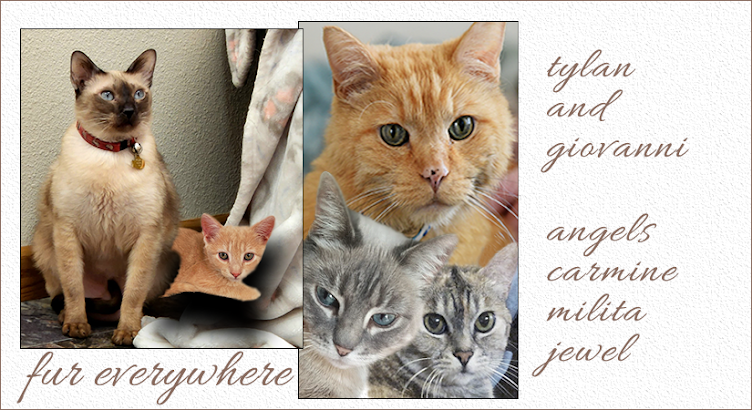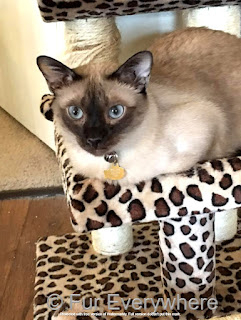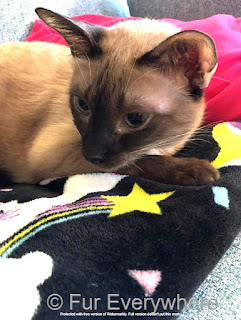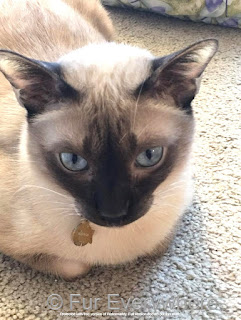Two weeks after I adopted my seal-point Siamese, Tylan, our vet took one look in his mouth and said, “He has stomatitis.” Little did I know that this would be one of the hardest battles I'd ever help a cat fight.
What is Stomatitis?
Feline Chronic Gingivostomatits (FCGS), commonly known as stomatitis, is a chronic condition that results from severe mouth tissue inflammation. According to Dr. Kate O'Hare, stomatitis affects 0.7-4% of cats.
Two types of stomatitis are recognized based on which part of the mouth is inflamed. The first form of the condition is characterized by inflammation that starts in the gums and the tissues surrounding the teeth. The second form is characterized by inflammation in the back of the mouth where the upper and lower jaws meet. This form may be more difficult to treat.
Cats of any breed and age can be affected by stomatitis. The most prominent symptom of the condition is severe mouth pain. Your cat may show his pain in a number of ways, including:
- Pawing
at his mouth.
- Rubbing
his face against furniture.
- Acting
aggressively if you try to touch his mouth or offer food.
- Crying
while eating, beginning to eat when he's offered a meal but stopping
suddenly, or refusing to eat at all.
- Hiding under furniture.
A cat with FCGS may also have an unkempt coat because he finds it too painful to groom himself. Cats with stomatitis may also have foul-smelling breath and drool. The drool may contain blood. A cat with FGCS may lose weight if he finds it too painful to eat. The affected parts of a cat's mouth will usually be bright red and bleed easily.
The exact cause of stomatitis isn't clear. However, there are several factors that likely contribute to the condition. The ingestion of toxins, viral exposure, uremia, allergic responses, plant foreign bodies, and immune-mediated causes have all been identified as possible factors contributing to the development of stomatitis in cats. The majority of cats with stomatitis are found to be shedding feline calcivirus and/or feline herpesvirus. No matter what the trigger is, it is generally thought that cats with stomatitis have an altered immune system that responds abnormally to the plaque bacteria in the mouth.
One theory is that a cat's gums are hypersensitive to bacterial plaque. Even a small amount of plaque causes the cat's immune system to overreact and produce an inflammatory response.
How is Stomatitis Diagnosed?
A diagnosis of stomatitis is generally made on the appearance of the lesions in the mouth. In order for a diagnosis of stomatitis to be made, the inflammation in the mouth must, “extend beyond the gingiva into the general oral mucosa and into the caudal regions of the oral cavity” asserts Animal Dentistry and Surgery.
It's important to note that feline bartonella was previously thought to be involved in oral inflammation. However, several studies have found that if bartonella is present in the mouth, it is not the cause of oral inflammation, according to Animal Dentistry and Oral Surgery.
How is Stomatitis Treated?
Treating FCGS can be challenging. Because there is no single known cause of the condition, there is also no single treatment for stomatitis. Rather, there are several things veterinarians can use to help manage the condition. Treatment options are often combined. It's important to note that every cat is an individual, and what works for one cat may or may not work for another.
Dental cleanings to reduce plaque are often the first line of treatment. After a dental cleaning is done in your vet's office, an at-home dental care routine should be attempted. This is not always possible, though, because stomatitis typically causes a cat severe mouth pain. Unfortunately, dental cleanings at a vet’s office are often unsuccessful for managing the condition long-term due to the fact that plaque bacteria repopulate the mouth shortly after a dental cleaning.
Antibiotics may be prescribed to help reduce bacteria in the mouth, which results in reduced inflammation. However, the inflammation typically returns shortly after antibiotics are discontinued, and long-term antibiotic use isn't ideal for cats.
Your vet may recommend partial or full-mouth extraction as a treatment option. While removing some or all of a cat's teeth might seem drastic, cats adapt quite well to having no teeth. Removal of the teeth removes plaque-retentive surfaces and reduces bacteria within the mouth.
Studies indicate that the majority of cats who have partial or full-mouth extractions respond positively to it. In one study, 24 out of 30 cats (80%) either improved significantly or were clinically cured from stomatitis after having most or all of their premolars and molars removed.
In another study involving 95 cats, it was found that 37 (39%) cats showed significant improvement and 27 (28.4%) cats were cured of stomatitis after either partial or full-mouth extraction. It should be noted, however, that of these 64 cats, 44 (68.8%) of them needed extended medical management for a finite period of time in order to achieve positive results.
Corticosteroids are another option for treating stomatitis. With corticosteroid injections, such as methylprednisolone, clinical improvement usually occurs rapidly, within 24 to 48 hours, and may last up to three to six weeks. Unfortunately, disease intervals typically shorten progressively and the treatment becomes ineffective.
A small preliminary study indicates that laser therapy may also be beneficial for cats with stomatitis. The study noted significant improvements in symptoms and inflammation following several laser therapy sessions.
Refractory Stomatitis
Refractory stomatitis is especially challenging to treat. While partial or full-mouth extraction is successful in significantly reducing or eliminating the inflammation and pain associated with stomatitis for the majority of cats, approximately 20% of cats will continue to experience a significant amount of inflammation and discomfort post-surgery. When this happens, a cat is diagnosed with refractory stomatitis.
The m goal for treating refractory stomatitis is reducing or eliminating mouth discomfort to the degree that a cat has a consistent appetite and is able to retain a healthy body weight.
Corticosteroids, mainly prednisolone, are often used to treat refractory stomatitis. However, there are some potentially undesirable side effects of long-term steroid use in cats. These side effects can include urinary tract infections, development of thin skin, poor or thin hair coat, obesity due to increased hunger, diabetes mellitus, muscle weakness secondary to protein breakdown, poor wound healing ability, and an increased susceptibility to fungal infections or secondary bacterial infections.
Cyclosporine is another medication that can be used to treat refractory stomatitis. In a double-blind study, seven out of nine cats who received cyclosporine for refractory stomatitis improved significantly whereas only one of the seven cats in the placebo group showed significant improvement.
Tylan's Story
Before I adopted Tylan, I was informed that he had undergone a near-full-mouth extraction due to resorptive lesions. Unbeknownst to me, he had a severe case of refractory stomatitis. In fact, Tylan's case was so bad that one of our vet techs who has worked at the clinic for more than 20 years told me Tylan’s case is one of the worst cases she's ever seen.
Despite his near-full-mouth extraction, Tylan had a ton of inflammation in the back of his mouth and throat.
We tried treating the inflammation with depo medrol injections, but the injections became less effective and eventually stopped working altogether within a matter of several months.
Tylan is a very social cat, and his favorite time of day is mealtime, but he was in so much pain that he often hid under my bed, and getting him to eat was next to impossible. It got to the point where I was giving him buprenorphine (a pain medication) on a regular basis just to get enough food into him to help him maintain his weight. It was absolutely heartbreaking to see Tylan suffering so much. What kind of life was this for a cat?
Time was quickly running out for Tylan. As much as I love him, I couldn't bear the thought of making him suffer for years to come with so much pain.
Fortunately, there was a new treatment option available for feline stomatitis – stem cell therapy. My vet just happened to be someone who could provide this treatment to his patients.
What is Stem Cell Therapy and How Can It Help Cats with Stomatitis?
Stem cells are unspecialized cells that can become any type of specialized cell in the body, such as blood cells, brain cells, bone cells, or muscle cells. Stem cell therapy is a type of regenerative medicine where stem cells replace damaged or diseased cells within the body. Stem cell therapy has been used to treat inflammatory, autoimmune, orthopedic, and neurological conditions in people.
Stem cells have been most commonly used to teat osteoarthritis in cats. However, stem cells have also been used in the treatment of chronic kidney disease, IBD, and stomatitis in cats as well.
The University of California, Davis has conducted several studies on the safety and efficacy of stem cell therapy on the treatment of refractory stomatitis in cats. In one such study, seven cats whose stomatitis did not respond to full-mouth tooth extraction and immunosuppressive therapies received two stem cell therapy treatments. Stem cells were derived from each cat’s fat tissue, collected under general anesthesia.
Of the seven cats who completed the study, three experienced complete clinical remission and two experienced substantial clinical improvement within one to four months of receiving their first stem cell therapy treatment. The remaining two cats had either minimal or no clinical response to the stem cell therapy treatments.
Cats who responded positively to stem cell therapy began to eat more, gain weight, resume grooming, and resumed socializing.
Stem Cell Therapy Was Tylan’s Last Hope
Though there are few published studies on the effectiveness of stem cell therapy in the treatment of severe feline refractory stomatitis, I decided to give it a try. Tylan had already had nearly all of his teeth (except for his two bottom canines) removed, and treatment with depo medrol was becoming less and less effective. Tylan was in an incredible amount of pain; he didn’t want to eat, and some days he didn’t even feel like socializing. Stem cell therapy was his last hope for living a quality life.
I was fortunate to have a vet who was trained to give stem cell therapy to cats. To get the cells needed for his treatment, Tylan had to undergo a fat collection surgery. My vet was able to collect three tubes of fat from Tylan’s abdomen.
The surgery was rough on Tylan. For two days, he spent most of his time sleeping, and he ate very little. I could tell that he was in a lot of pain and felt terrible for him.
Two days after his surgery, I took Tylan back to the vet for his first stem cell therapy treatment.
I won’t lie. I didn’t see a lot of improvement after Tylan’s first treatment. However, my vet had said that most of the time, it takes two to four treatments before significant improvement is seen in cats with stomatitis.
Tylan went for his second treatment one month after his first. He underwent a third treatment a month after the second one.
My vet contacted the stem cell manufacturing company’s CEO to consult with him after Tylan’s third treatment. While we saw some improvement in Tylan’s mouth and throat inflammation, my vet had hoped to see more improvement than we were seeing.
For his fourth treatment, Tylan ended up getting a double dose of stem cells. That is when I noticed things really turn around. Tylan was obviously in less pain, eating more, and was social on most days.
I took Tylan in for a follow-up about a month after his fourth and final stem cell therapy treatment. My vet said he could see significant improvement in his inflammation.
Despite the marked improvement, though, Tylan was still in pain on a number of days.
It took a lot of trial-and-error over the next year for us to find a prednisolone regimen that works to keep Tylan’s pain and inflammation under control.
It’s been over two years since Tylan underwent stem cell therapy now. He enjoys his meals (and often tries to steal Carmine’s food), is very social, doesn’t hide, and is no longer in pain. His quality of life has improved dramatically.
My vet always says he feels bad that Tylan didn’t go into complete remission with the stem cell therapy, but I remind him that Tylan wouldn’t even be here with us if it weren’t for stem cell therapy. It was the combination of stem cell therapy and immunosuppressive medication that has allowed Tylan to live a quality life – something that would not have been possible if one therapy were used without the other.
I am beyond thankful that stem cell therapy helped save Tylan’s life.
Is Stem Cell Therapy Right for Your Cat?
That’s something I can’t answer for you. If you’re interested in stem cell therapy for your cat, I would advise you to talk to your vet about it. Your vet may not be trained to administer stem cell therapy, but he or she may be able to refer you to someone who is.
Stem cell therapy is quite expensive. It should also be noted that it does not work for every cat. In Tylan’s case, his refractory stomatitis was severe, and while stem cell therapy most certainly improved his condition, it did not completely cure him.
Only you can decide what is best for your cat. I’m happy I decided
to try stem cell therapy for Tylan. It gave him the second chance he deserves.
References:
MSPCA Angell: Feline Stomatitis
Veterinary Practice News: Why Teeth Removal is Best When Your Patient Has Feline Stomatitis
Animal Dentistry & Oral Surgery: Stomatitis
The Spruce Pets: Stomatitis in Cats
Veterinary Practice News: Feline Stomatitis: Medical Therapy for Refractory Cases
SM Dermatology Journal: NIR Laseer Therapy in the Management of Feline Stomatitis
VCA Animal Hospitals: Steroid Treatment - Effects in Cats
DVC Stem: What is Stem Cell Therapy?
Mayo Clinic: Stem Cells: What They Are and What They Do
Today's Veterinary Practice: Continuing Education: Feline Chronic Gingivostomatitis
YouTube: Regenerative Medicine and the Feline Patient






Scientists and doctors learn new things every day.
ReplyDeleteGlad to read that Tylan is happy and as healthy as can be.
Happy New Year!
Thank you for this very informative post. I have two cats with stomatitis - steroids don't seem to help either one much, but I will discuss the possibility of laser treatment as that is an option we haven't looked into yet. Purrs and purrayers to you and Tylan and of course Carmine too !
ReplyDeleteTylan has had quite the journey but he was with you and you weren't about to give up on that sweet guy. You are so fortunate to have found each other.
ReplyDeleteI am glad the stem cell helped Tylan. I know someone whose cat has FIV and this, but still has trouble despite having all teeth extracted so I will tell them about this. XO
ReplyDeleteWow, I am so glad that Tylan got that new treatment and it helped oim so much! You didn't give up and neither did he. NOw he can be the kiitty e was meant to be:)
ReplyDeleteHappy New Year to you, Tylan and Carmine!
I remember when Tylan was going through all of this. I'm glad Tylan is doing well now. Happy New Year!
ReplyDeleteWe are really glad that Tylan is doing so well now! Happy New Year! XO
ReplyDelete